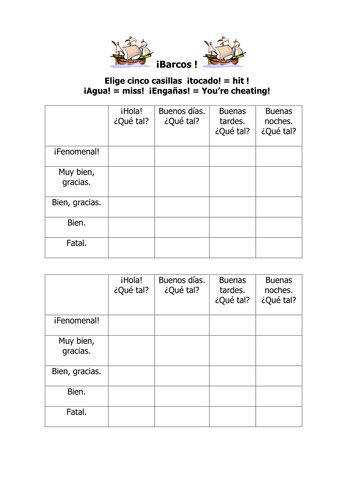

This worksheet has 3 sections, the first is a word match for English and Spanish greetings.
Vocabulary:
1. Hola.
2. Buenos días.
3. Buenas tardes.
4. Buenas noches.
5. ¿Qué tal?
6. ¡Fenomenal!
7. Muy bien, gracias.
8. Bien, gracias.
9. Bien.
10. Fatal.
The next section is a complete the sentence challenge where certain letters have been removed. Make this more difficult by telling the students to cover up the Spanish words listed above.
The next (extra) section involves unjumbling a group of words to find the correct greetings. Again, make this more difficult by telling the students to cover up the Spanish words listed above.
Then there is an extension task to create their own crossword.
Battleships:
Vocabulary:
1. Hola.
2. Buenos días.
3. Buenas tardes.
4. Buenas noches.
5. ¿Qué tal?
6. ¡fenomenal!
7. Muy bien, gracias.
8. Bien, gracias.
9. Bien.
10. Fatal
Battleships Game
Instructions
The students love this competitive and fun game!
I use this battleships game (which can also be used as a lotto grid) to help students to practise their pronunciation and to reinforce new vocabulary and grammatical structures.
Firstly I ask the students to work independently in pairs to translate the expressions.
The students then focus on pronunciation and decide the two easiest and two most difficult words to pronounce.
I then check the translations and drill pronunciation with the whole class before they play the game.
The students secretly choose 5 squares on the top grid and then try to guess which 5 squares their partner has chosen, filling in the bottom grid with “hit” and “miss.” To choose a square say a phrase from the horizontal line and complete the sentence with a phrase from the vertical line. Where the 2 phrases meet up is the square you have chosen.
I use the English language sheet to further challenge the students: they should place this on top of the Spanish version and then try to play the game saying the Spanish phrases as far as possible from memory. I allow the really weak students to have the Spanish version next to the English version so they have lots of support, stronger students are allowed a few “sneaky peaks” at the Spanish version and the really strong students aim to refer back to the Spanish version as little as possible. This really helps the students to memorise the vocabulary/structures!
During the game I circulate the classroom checking pronunciation. This is followed by whole class drilling of pronunciation mistakes.
Enjoy!
Vocabulary:
1. Hola.
2. Buenos días.
3. Buenas tardes.
4. Buenas noches.
5. ¿Qué tal?
6. ¡Fenomenal!
7. Muy bien, gracias.
8. Bien, gracias.
9. Bien.
10. Fatal.
The next section is a complete the sentence challenge where certain letters have been removed. Make this more difficult by telling the students to cover up the Spanish words listed above.
The next (extra) section involves unjumbling a group of words to find the correct greetings. Again, make this more difficult by telling the students to cover up the Spanish words listed above.
Then there is an extension task to create their own crossword.
Battleships:
Vocabulary:
1. Hola.
2. Buenos días.
3. Buenas tardes.
4. Buenas noches.
5. ¿Qué tal?
6. ¡fenomenal!
7. Muy bien, gracias.
8. Bien, gracias.
9. Bien.
10. Fatal
Battleships Game
Instructions
The students love this competitive and fun game!
I use this battleships game (which can also be used as a lotto grid) to help students to practise their pronunciation and to reinforce new vocabulary and grammatical structures.
Firstly I ask the students to work independently in pairs to translate the expressions.
The students then focus on pronunciation and decide the two easiest and two most difficult words to pronounce.
I then check the translations and drill pronunciation with the whole class before they play the game.
The students secretly choose 5 squares on the top grid and then try to guess which 5 squares their partner has chosen, filling in the bottom grid with “hit” and “miss.” To choose a square say a phrase from the horizontal line and complete the sentence with a phrase from the vertical line. Where the 2 phrases meet up is the square you have chosen.
I use the English language sheet to further challenge the students: they should place this on top of the Spanish version and then try to play the game saying the Spanish phrases as far as possible from memory. I allow the really weak students to have the Spanish version next to the English version so they have lots of support, stronger students are allowed a few “sneaky peaks” at the Spanish version and the really strong students aim to refer back to the Spanish version as little as possible. This really helps the students to memorise the vocabulary/structures!
During the game I circulate the classroom checking pronunciation. This is followed by whole class drilling of pronunciation mistakes.
Enjoy!
Something went wrong, please try again later.
This resource hasn't been reviewed yet
To ensure quality for our reviews, only customers who have purchased this resource can review it
Report this resourceto let us know if it violates our terms and conditions.
Our customer service team will review your report and will be in touch.
£2.00
